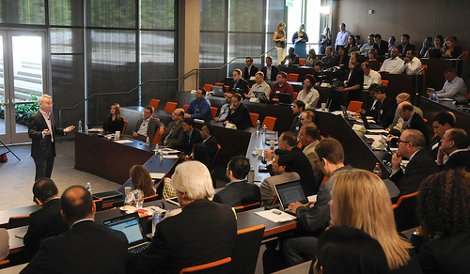VMware unveiled its public-cloud services Tuesday morning (US Pacific time) called vCloud Hybrid Service. The Palo Alto, California-based company is promising seamless integration between on-premise infrastructure and the public cloud without any changes to existing applications.
An early access program will start in June and the service will go into general availability in the US in the third quarter of 2013. The company plans to roll it out in Europe, Middle East, Africa and Asia next year.
VMware calls its strategy as a cloud provider “inside-out”, where existing applications running in customers' own data centers are seamlessly extended into the public cloud to take advantage of the elasticity it provides. The vendor is also billing the service as a way to deploy new applications that use both on-premise and cloud-borne resources.
The company's CEO Pat Gelsinger described the goal as “any application, any place, any cloud, without any changes.”
vSphere install base: a built-in market
VMware's server-virtualization technology has allowed an application to run on any physical server within a data center without ever being aware which machine it is running on. “Now, the promise is I can deliver it on any data center, and the application didn't change,” Gelsinger said in a press conference in Palo Alto Tuesday.
The service uses VMware's vSphere technology as a foundation, which means existing vSphere customers' infrastructure is already compatible with the public-cloud service. The vendor offers them a free vCloud Connector plug-in.
To make the hybridization of a client's infrastructure seamless, the service is supposed to extend the client's in-house network into a VMware data center and replicate their security environment there, after which the client's application can be deployed in the VMware data center the same way it is deployed on-premise.
“You can seamlessly replicate existing networking environment you have on premise and extend it into the public cloud,” Bill Fathers, senior VP and general manager of hybrid cloud at VMware, said. “This is the bit of detail that saves our clients a lot of time and money.”
The automatic integration of on-premise infrastructure and public cloud will give VMware a major edge over other public-cloud providers – such as Amazon Web Services, Microsoft or Rackspace – if it works the way the company describes it. Clients of the dominant public-cloud players currently have to do a lot of the technological leg-work themselves if they want to burst their in-house environment into provider clouds.
VMware's cloud in outsourced data centers
It will be hard for VMware's cloud to compete with the incumbent players on scale of infrastructure, however. Companies like Amazon, Microsoft and Rackspace have already spent a lot of time and money on building out global data center networks specifically for the purpose of hosting the services they provide.
VMware said it will start by hosting its public cloud in four data centers it leases from third-party providers. The facilities are in Santa Clara, California, Las Vegas, Nevada, Dallas, Texas, and Sterling, Virginia.
Two types of offerings will be available at launch: Dedicated Cloud and Virtual Private Cloud. As the names suggest, the former is a physically isolated private-cloud instance, while the latter is a logically isolated cloud deployed in a shared environment.
Pricing for dedicated cloud will start at US$0.13 per hour for a fully protected and fully redundant 1GB virtual machine with one processor. The company will sell virtual private cloud instances starting at $0.045 per hour for 1GB of memory and one processor, which will also be fully protected and redundant.
Gelsinger also announced VMware's expanded partnership with the German business-software giant SAP, whose software, including the popular SAP Hana, VMware will now provide as a subscription-based service on-premise and in the cloud. This is the first time a public cloud provider has offered SAP software in production as a service, Gelsinger said.
On the heels of Google's IaaS cloud
VMware's announcement comes less than one week after Google launched its public cloud infrastructure services called Compute Engine into general availability. The internet giant's IaaS offering has been online and available to a select few early adopters for about one year, but on 15 May it became available to everyone.
Google prides itself on the performance, cost efficiency and massive scale of the global data center infrastructure it has built out over the past 14 years and the main pitch for its public cloud is that it provides an opportunity for anyone to take advantage of that infrastructure.
When it announced Compute Engine's general availability, Google also introduced the idea of “sub-hour” billing for cloud services. The standard unit of measurement for usage of a cloud-borne virtual server by customers of providers like Amazon and others has traditionally been one hour.
Urs Hoezle, Google's senior VP of technical infrastructure, said this was not the most efficient billing model, because developers often needed to deploy cloud VMs for shorter periods of time. While Google has per-minute pricing for cloud compute power clients spin up, they have to pay for a minimum of 15 minutes.

